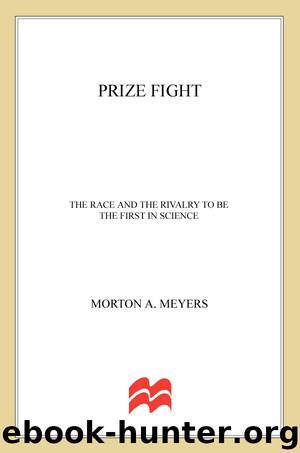Prize Fight by Morton Meyers M.D

Author:Morton Meyers, M.D.
Language: eng
Format: epub
Publisher: St. Martin's Press
Published: 2012-03-19T16:00:00+00:00
Figure 8.2 Paul Lauterbur’s notebook entry of September 2, 1971, citing Raymond Damadian’s earlier article in Science. [DBC]
Lauterbur figured out how to create a series of one-dimensional projections by changing the orientation of the gradient field and then, with the help of a physicist skilled in mathematics from the nearby Brookhaven National Laboratory, how to reconstruct a two-dimensional image from a mass of data in the form of “slices.” Several years ago, I asked Lauterbur how he felt about coming up with the key to solving the imaging problem. With his typical crinkly-eyed smile, he simply concluded, “Everything fell into place!”15 The exhilaration in this statement conveys multiple parameters: an incisive and receptive mind, the joy of insight, the aesthetic elegance of a synthesis, and the introduction of a new view of the universe. He knew that he had reached a turning point: “I had stumbled across an idea that was worth spending most of my time on for the foreseeable future instead of carrying on with molecular structure studies.”16 He places his insight among “the unexpected breakthroughs that grow in the fertile soil of ‘curiosity-driven’ research,” adding that this is “the most cost effective kind in the long run.”17
Lauterbur was not so starry-eyed that he failed to anticipate NMR’s potential for practical applications. Even as he was developing his technique, he also concentrated his efforts on a delicate balance between two major pursuits: publication in a prestigious journal with a wide readership and the security of inviolable patent rights. The first would clearly establish his scientific priority, and the other would legalize his intellectual property rights. He was fully aware that any patent was his exclusively, because the technique was a summer epiphany and not discovered on university time.
To trace the chronology of these two efforts is to raise questions regarding motives and the truthfulness of attributions.
By the end of October, Lauterbur was in contact with Edward D. Welsh, a patent attorney based in Pittsburgh who provided counsel to NMR Specialties. In a letter to Welsh dated November 10, 1971, Lauterbur raised and dismissed the idea of potentially useful and profitable collaboration with Damadian: “Damadian and I neither like nor trust one another.”18 He was referring to his first contact with Damadian a year and a half to two years earlier, which established an immediate distrust that would grow to a bitter relationship over the next thirty years. At that time, if his $89,000 grant application in September 1969 were accepted, Damadian planned to buy a superconducting NMR spectrometer from NMR Specialties. In an apparently bull-headed manner, according to Vickers, Damadian called Lauterbur and said he was listing him as a reference on the grant application, and “since you are on the board of NMR Specialties, I expect a favorable review.” Vickers comments: “Everything went downhill from there.”19 Besides, the company was faltering financially and was not in a position to produce the magnet. For his part, Damadian views Lauterbur’s rejection as deliberate sabotage born of a competitive impulse
Download
This site does not store any files on its server. We only index and link to content provided by other sites. Please contact the content providers to delete copyright contents if any and email us, we'll remove relevant links or contents immediately.
| Administration & Medicine Economics | Allied Health Professions |
| Basic Sciences | Dentistry |
| History | Medical Informatics |
| Medicine | Nursing |
| Pharmacology | Psychology |
| Research | Veterinary Medicine |
The Salt Fix by Dr. James DiNicolantonio(1638)
Rebecca Skloot by The Immortal Life of Henrietta Lacks(1630)
Stiff - The Curious Lives of Human Cadavers by Mary Roach(1425)
Rigor Mortis by Richard Harris(1379)
Undue Risk by Moreno Jonathan D.;(1297)
The Telomerase Revolution by Michael Fossel(1284)
Extremes: Life, Death and the Limits of the Human Body by Fong Kevin(1195)
07 by H. M. Ward(1135)
01 by H. M. Ward(1109)
02 by H. M. Ward(1102)
Kathryn Bowers & Barbara Natterson-Horowitz by Zoobiquity(1101)
Essentials of Biostatistics in Public Health by Sullivan & Sullivan(1093)
06 by H. M. Ward(1082)
03 by H. M. Ward(1038)
05 by H. M. Ward(1031)
Why We Snap: Understanding the Rage Circuit in Your Brain by Douglas Fields(1025)
04 by H. M. Ward(1016)
Critical Thinking: Understanding and Evaluating Dental Research by Donald Maxwell Brunette(1001)
A Life Everlasting by Sarah Gray(986)
